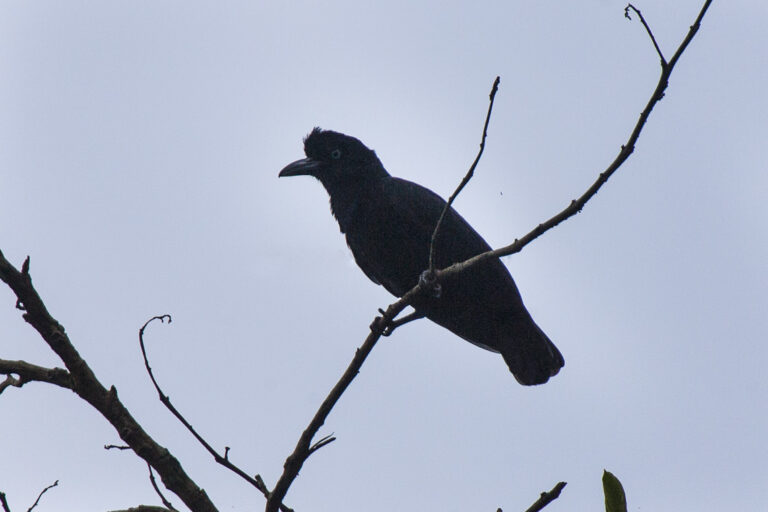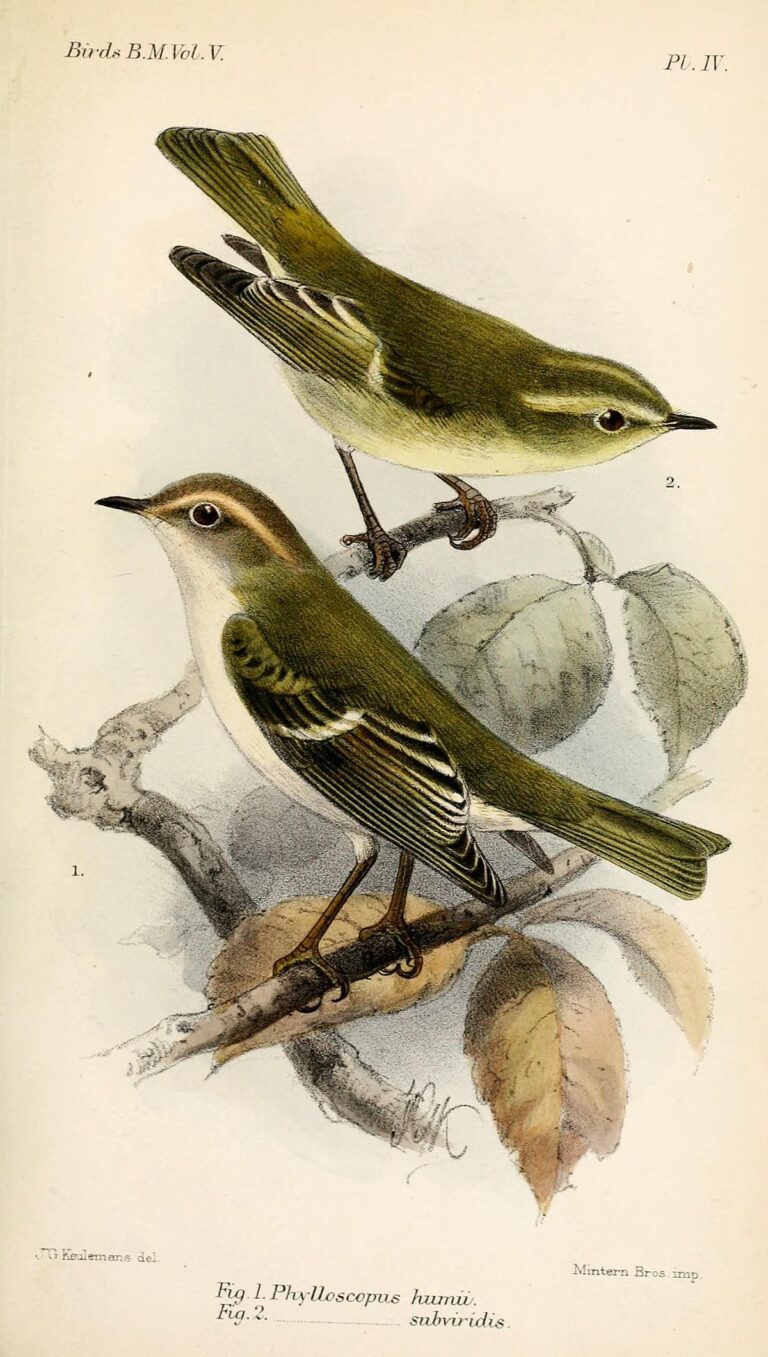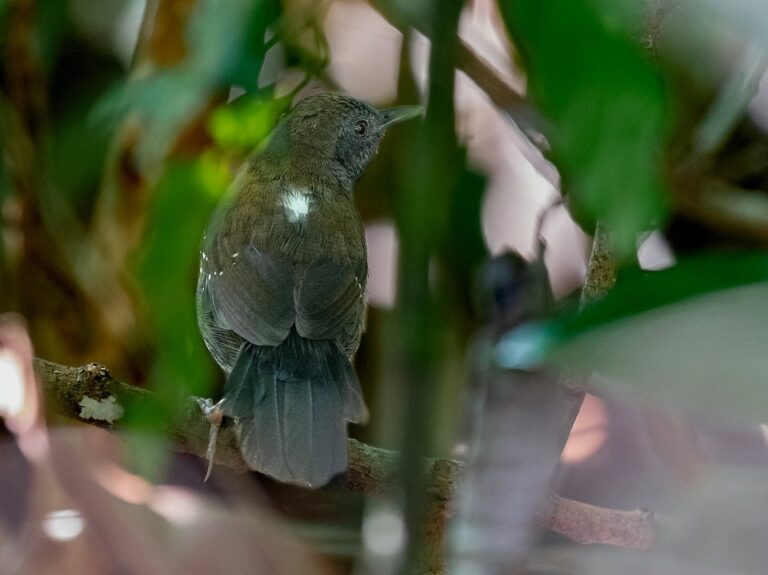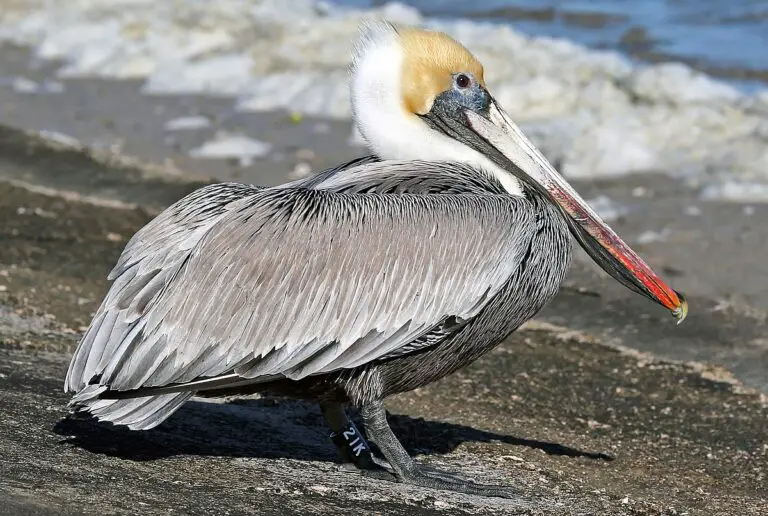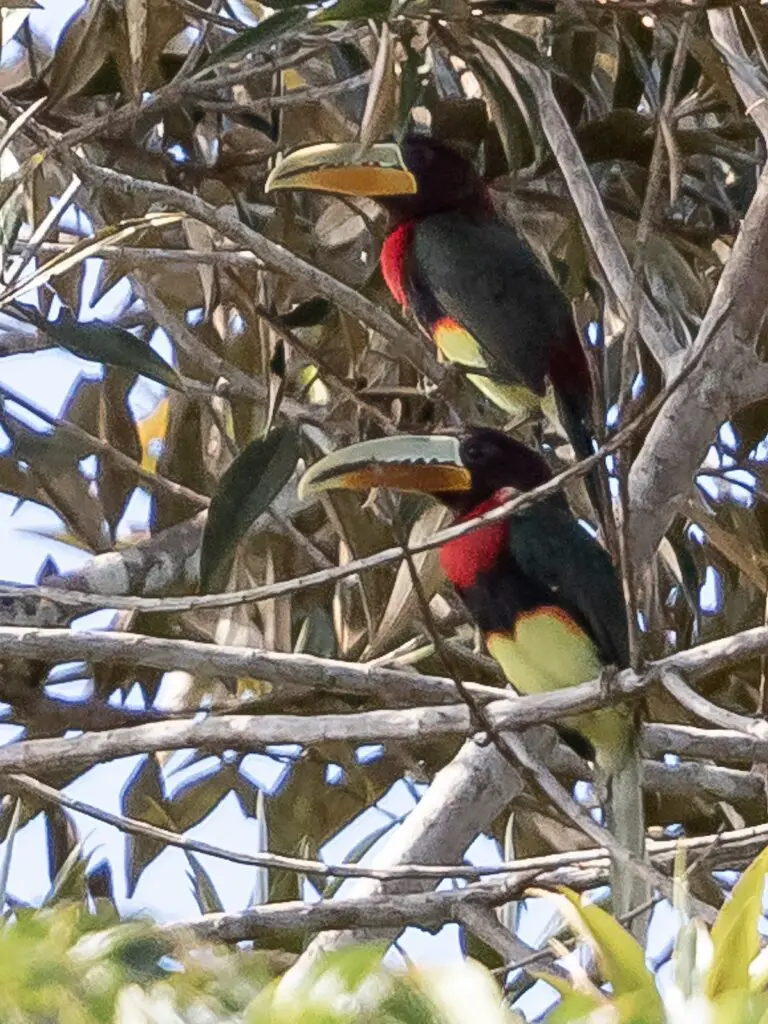Vermilion Flycatcher (Pyrocephalus obscurus)
“They have a fast song that lasts up to 10 syllables at max.”
Scientific Classification:
- Kingdom: Animalia
- Phylum: Chordata
- Class: Aves
- Order: Passeriformes
- Family: Tyrannidae
- Genus: Pyrocephalus
- Species: Pyrocephalus obscurus
Conservation Status: Least Concern
Locations: Vermilion Flycatchers can be found in Central America, North America, and South America.
Facts about the Vermilion Flycatcher:
Prey: Vermilion Flycatchers primarily feed on flies, butterflies, grasshoppers, beetles, and crickets.
Name Of Young: The young of Vermilion Flycatchers are called chicks.
Group Behavior: They are mainly solitary birds.
Fun Fact: Vermilion Flycatchers have a fast song that can last up to 10 syllables at max.
Estimated Population Size: The population of Vermilion Flycatchers is estimated to be between 5,000,000 to 50,000,000 individuals.
Biggest Threat: Urbanization poses a significant threat to Vermilion Flycatchers.
Wingspan: They have a wingspan ranging from 9.4 to 9.8 inches.
Incubation Period: The incubation period for Vermilion Flycatcher eggs is about 2 weeks.
Age Of Independence: Vermilion Flycatcher chicks become independent at around 15 days old.
Diet: They are insectivores, primarily feeding on insects.
Average Litter Size: Vermilion Flycatchers typically lay clutches of 2-4 eggs.
Nesting Location: They nest in trees.
Migratory: Vermilion Flycatchers are partially migratory.
Physical Characteristics:
- Color: Vermilion Flycatchers exhibit colors such as brown, red, orange, and grey-brown.
- Skin Type: Their skin is covered in feathers.
- Lifespan: They have a lifespan of around 4-5 years.
- Weight: Vermilion Flycatchers weigh between 0.39 to 0.49 ounces.
- Height: They stand at around 3.1 inches tall.
- Length: Their length ranges from 5.1 to 5.5 inches.
- Age of Sexual Maturity: Vermilion Flycatchers reach sexual maturity at around 2 years of age.
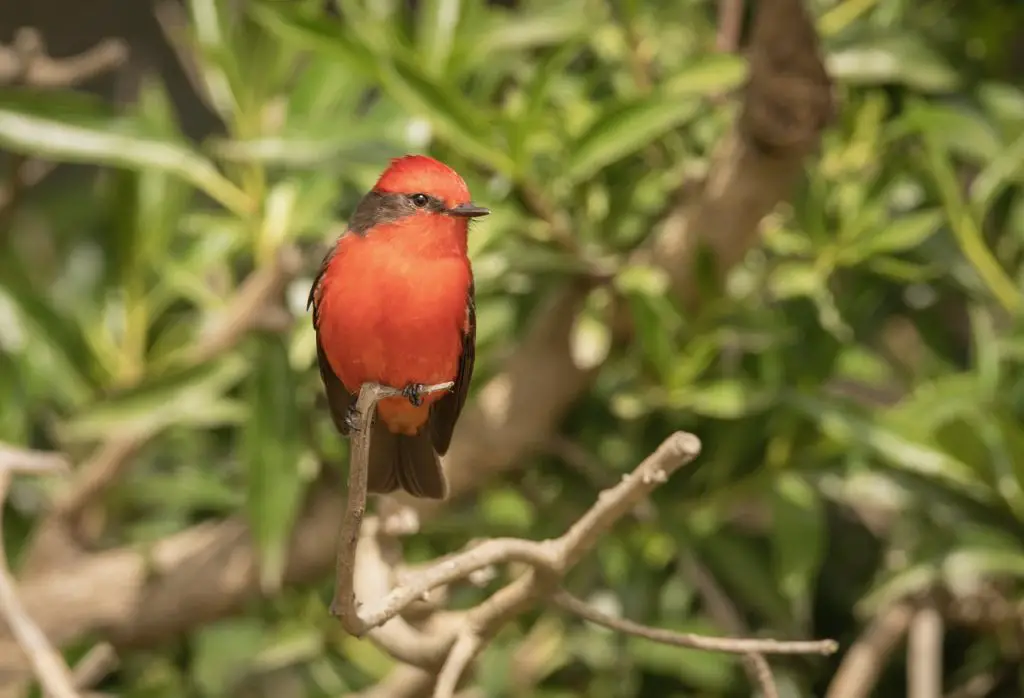
The Vermilion Flycatcher, a perching bird native to South America and certain regions of North America, exhibits notable sexual dimorphism in coloration. Male Vermilion Flycatchers boast vibrant hues, setting them apart from the more subtly colored females. This distinction can make identifying females more challenging due to their comparatively muted appearance.
One of the Vermilion Flycatcher’s distinctive traits is its unique singing voice, which is characterized by variability yet plays a crucial role in reinforcing the species’ population. This vocalization likely serves multiple purposes, including territory defense, mate attraction, and communication within the population.
Overall, the Vermilion Flycatcher’s striking appearance and vocal prowess contribute to its significance in both its natural habitat and among bird enthusiasts worldwide.
4 Amazing Vermilion Flycatcher Facts
The Vermilion Flycatcher’s vibrant coloration can fade when males are kept in captivity, highlighting the importance of their natural environment for maintaining their striking appearance. While not typically kept as pets due to their unsuitability for domestication and their preference for wild habitats, there exists a superstition regarding them as a symbol of good luck.
During the mating season, male Vermilion Flycatchers engage in captivating aerial displays, performing intricate dances in the sky to impress potential mates. This courtship behavior showcases their agility and vigor, serving as a spectacle of their reproductive prowess.
Interestingly, Vermilion Flycatchers exhibit a reproductive strategy known as brood parasitism, where they leave their young to be tended by other birds. This behavior, while uncommon among birds, allows them to allocate more resources towards reproduction while leveraging the care provided by other species for their offspring.
The Vermilion Flycatcher’s behavior and appearance make it a fascinating subject of study and admiration, both in its natural habitat and in cultural contexts where it is regarded with superstition and awe.
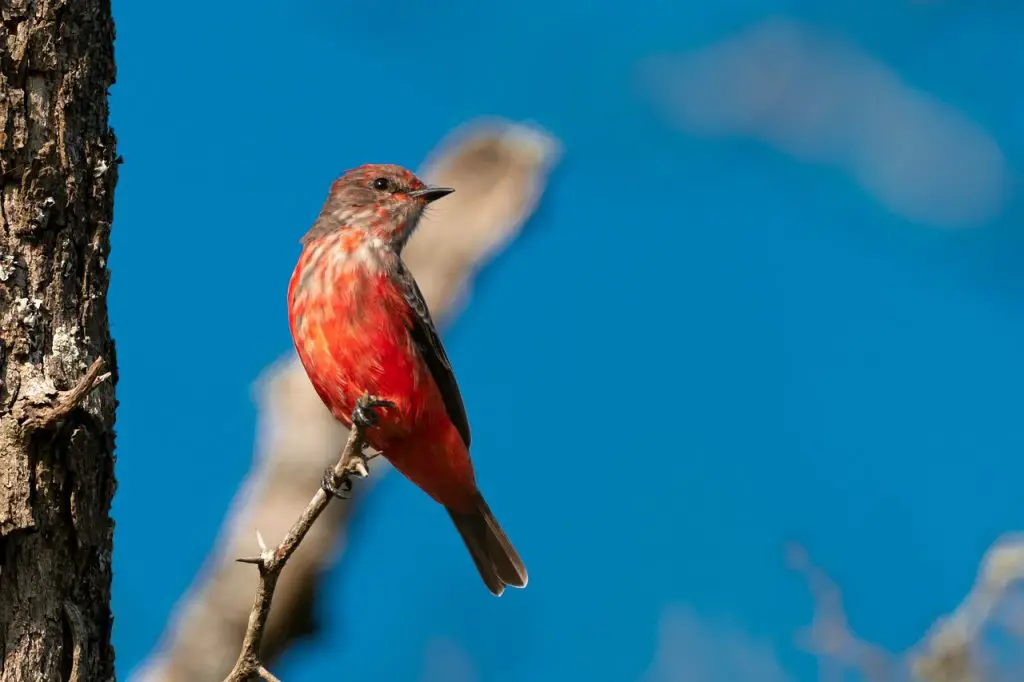
Where to Find Vermilion Flycatcher?
The Vermilion Flycatcher’s habitat and seasonal presence offer ample opportunities for observation. They can be found throughout the year in various environments, including woodland areas, scrublands, farmlands, deserts, parks, savannas, shrubby areas, and near water sources. Their range spans both Southern and Northern America, and they can be observed at elevations of up to 10,000 feet above sea level.
For optimal sightings, one should focus on insect-rich areas during the months of December to May, which coincides with their breeding season. During this time, Vermilion Flycatchers are particularly active and conspicuous as they engage in courtship displays and nesting activities. Keeping an eye out for their vibrant colors and distinctive aerial maneuvers in these habitats can increase the chances of encountering these captivating birds in their natural environment.
Indeed, spotting the Vermilion Flycatcher requires keen observation, as they often perch atop trees or near bodies of water, displaying their magnificent coloration. Their vibrant red and orange plumage makes them easily identifiable, with males standing out prominently against the surrounding landscape, while females exhibit a more subdued gray appearance.
Their melodious songs serve as a helpful auditory cue, guiding observers to their location from a distance. Whether perched on trees, near lakeshores, or even on streetlights along roadsides, Vermilion Flycatchers can be found in a variety of open habitats, making them relatively easy to spot.
During the breeding season, Vermilion Flycatchers show a preference for specific tree species such as cottonwood, mesquite, and Goodding’s willow, where they establish nesting sites and engage in courtship displays. Winter months, when they gather in flocks, provide an excellent opportunity for birdwatchers to observe these charismatic birds in greater numbers.
Vermilion Flycatcher Nests
The nest construction of the Vermilion Flycatcher is indeed remarkable and tailored to provide both structural stability and camouflage from potential predators. Constructed primarily of twigs, grass, empty cocoons, and spider webs, the cup-shaped nest is meticulously woven together and often concealed under lichen to blend seamlessly into its surroundings.
To further fortify the nest and provide insulation, it is lined with feathers, hair, and other plant materials. This combination of materials creates a cozy and secure environment for nesting and raising young.
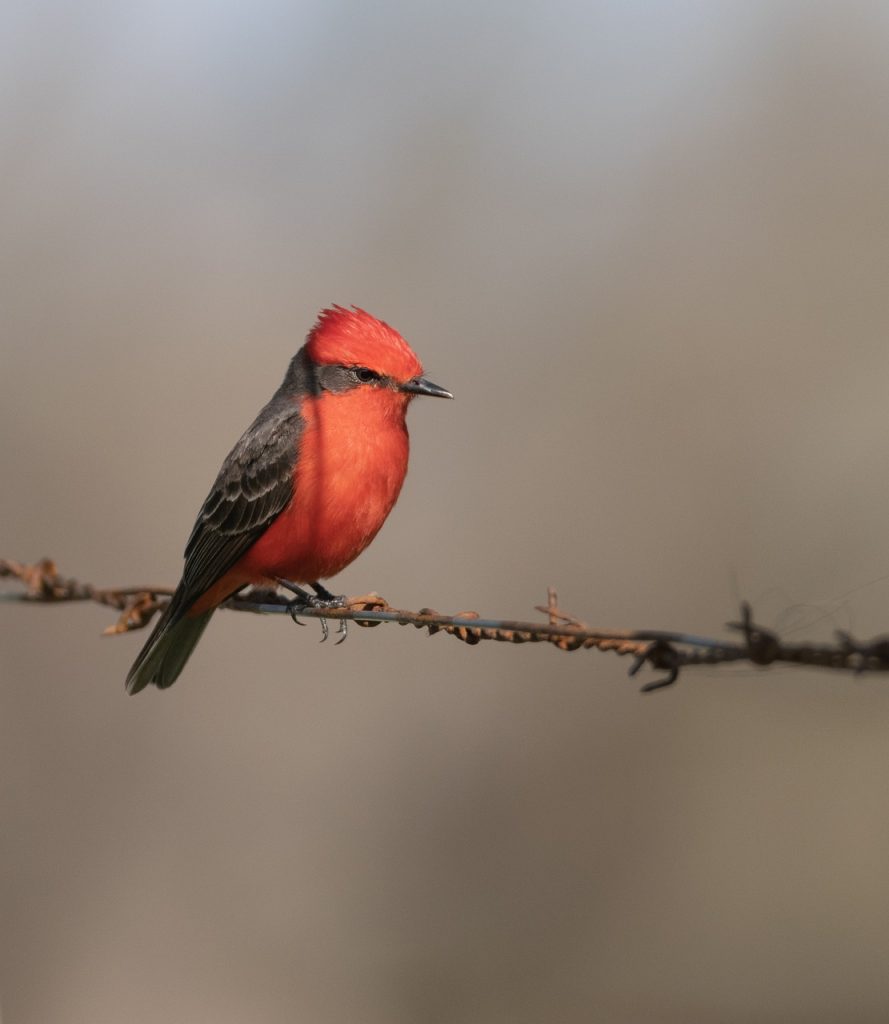
Typically perched around 20 inches above the ground, Vermilion Flycatcher nests are strategically positioned within the canopy of trees, providing a vantage point for observing and defending against predators while also offering protection from the elements. While most nests are situated at relatively low heights, occasionally they may be found higher, up to 50 inches above the ground.
Vermilion Flycatcher eggs are generally white in color with a scattering of brown, olive, or lavender spots. Clutches typically consist of 2-4 eggs, which are incubated by the female for approximately two weeks before hatching. This nesting behavior reflects the species’ adaptation to its habitat and its commitment to ensuring the survival of its offspring in the face of potential threats.
Vermilion Flycatcher Scientific name
The taxonomic history of the Vermilion Flycatcher, also known as Pyrocephalus obscurus, includes various scientific names and classification debates over the years. Initially described as Pyrocephalus obscurus in 1839, it was also referred to as Pyrocephalus rubinus in 1840. Both names have Greek origins and were used interchangeably for describing the species. However, Pyrocephalus rubinus is now recognized as the name for another bird species, the Scarlet Flycatcher.
Belonging to the Class Aves and the Tyrannidae family, the Vermilion Flycatcher has undergone taxonomic revisions regarding its species and subspecies. Prior to 2013, there were claims of nearly 13 species within the Vermilion Flycatcher group. However, a 2016 study refuted this claim and identified nine subspecies of the Vermilion Flycatcher:
- P. o. obscurus
- P. o. mexicanus
- P. o. saturatus
- P. o. blatteus
- P. o. flammeus
- P. o. ardens
- P. o. cocachacrae
- P. o. piurae
- P. o. pinicola
These subspecies exhibit variations in geographic distribution, plumage coloration, and other morphological characteristics, contributing to the biodiversity of the Vermilion Flycatcher across its range.
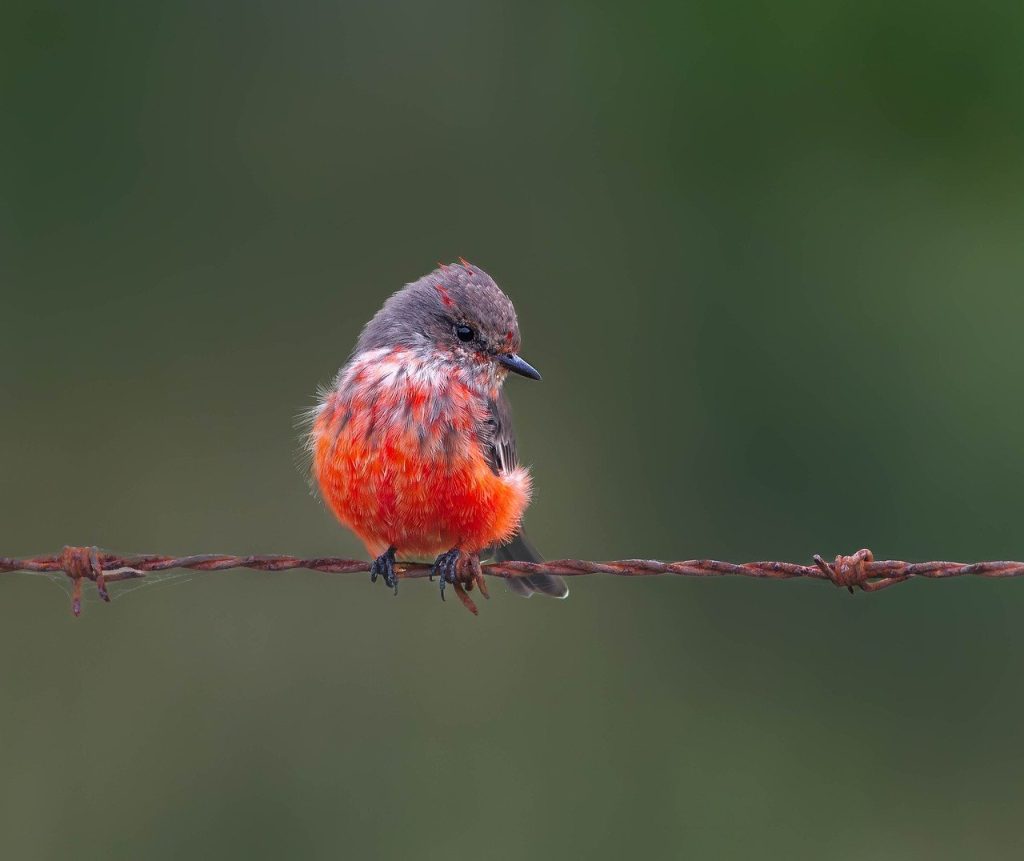
Vermilion Flycatcher Size, Appearance, & Behavior
The Vermilion Flycatcher possesses a distinctive appearance characterized by its small, round body and straight bill. It features a short head, a barrel-chested build, and a stout body, contrasting with its long and slender tail. Measuring between 5.1 to 5.5 inches in length and 3.1 inches in height, with a weight ranging from 0.39 to 0.49 ounces, the Vermilion Flycatcher is compact yet elegant in form. Its wingspan extends impressively to 9.4 to 9.8 inches, enabling agile flight and precise maneuvers.
The genders of Vermilion Flycatchers exhibit striking differences in coloration. Male individuals display vibrant reddish-orange tones, particularly noticeable beneath a brown mask of feathers covering the body. In contrast, females possess a gray overall coloration with white undertones, complemented by an attractive brush of amber shades below. While males are easily distinguished by their vivid plumage, females can be mistaken for the Say’s Phoebe, a similar-looking bird species. This sexual dimorphism adds to the allure and intrigue of the Vermilion Flycatcher, making it a captivating subject for birdwatchers and enthusiasts alike.
Vermilion Flycatcher Migration Pattern and Timing
Migration plays a crucial role in the life cycle of the Vermilion Flycatcher, contributing to the expansion of their population. Interestingly, there is a notable geographical pattern in their migration behavior. Southern populations of Vermilion Flycatchers undertake migratory journeys to the North during the migration season, which typically begins in early March. In contrast, Northern populations exhibit a more sedentary lifestyle, with individuals being less inclined to migrate, resulting in them being non-migratory.
During migration, Vermilion Flycatchers move to warmer regions, where they can find suitable habitats and abundant food resources. This seasonal movement allows them to escape harsh winter conditions and ensures their survival and reproductive success.
While Vermilion Flycatchers are typically solitary birds, they may form small flocks, especially during the winter season. These flocks usually consist of no more than five individuals, providing opportunities for social interactions and cooperative foraging. Despite their solitary nature, these brief gatherings highlight the importance of social dynamics and cooperation in the lives of these charismatic birds.
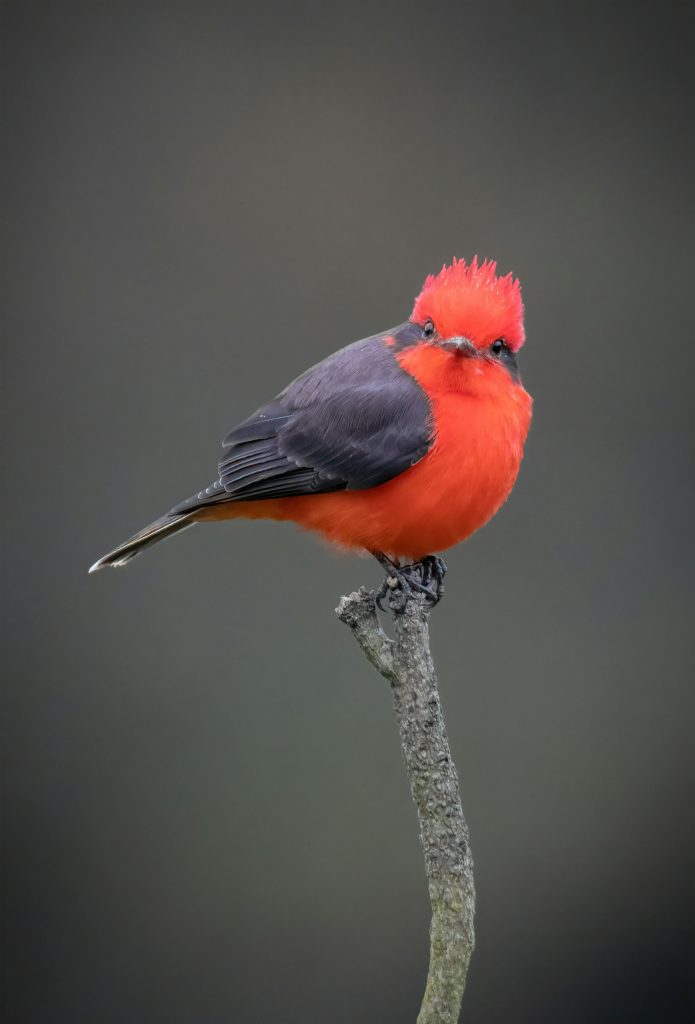
Vermilion Flycatcher Diet
The Vermilion Flycatcher’s diet primarily consists of insects, reflecting their strict insectivorous nature. They consume a diverse range of prey, including honeybees, butterflies, grasshoppers, beetles, and crickets, showcasing their adaptability to various insect species.
Their feeding behavior is characterized by perching in elevated positions, providing them with a bird’s-eye view of their surroundings. From these vantage points, they keenly observe foraging opportunities and swiftly swoop down to capture insects in flight or on the ground.
Once they have secured their prey, Vermilion Flycatchers return to their perching site to consume it. They may also consume insects directly from the ground if suitable prey is present. Before consumption, they often kill their prey to facilitate ingestion.
Additionally, Vermilion Flycatchers expel indigestible parts of their diet in the form of pellets, a common behavior observed in many bird species.
The Vermilion Flycatcher’s feeding strategy involves efficient hunting techniques, strategic positioning, and selective prey capture, enabling them to meet their dietary needs while conserving energy for other essential activities.
Vermilion Flycatcher Predators, Threats, and Conservation Status
The Vermilion Flycatcher is currently classified as Least Concern, indicating that it does not face significant threats to its population size, and its numbers are stable or increasing. This positive trend is attributed in part to its migration pattern, which allows populations to expand into new areas and utilize diverse habitats.
Despite its overall resilience, the Vermilion Flycatcher is not immune to predation. One of its most common predators, particularly in certain regions like the Galapagos, is rats. Rats pose a threat not only to adult Vermilion Flycatchers but also to their eggs and young, preying on nests and reducing reproductive success.
However, the species faces more significant threats from human activities, particularly urbanization and habitat loss. Deforestation, driven by urban expansion and agricultural development, diminishes suitable habitats for Vermilion Flycatchers, reducing the availability of nesting sites and foraging areas. Additionally, the overuse of pesticides contributes to declines in insect populations, which are a primary food source for Vermilion Flycatchers, thereby impacting their survival.
Addressing these threats through habitat conservation, sustainable land management practices, and pesticide regulation is essential for ensuring the long-term survival of the Vermilion Flycatcher and maintaining its status as a species of Least Concern.
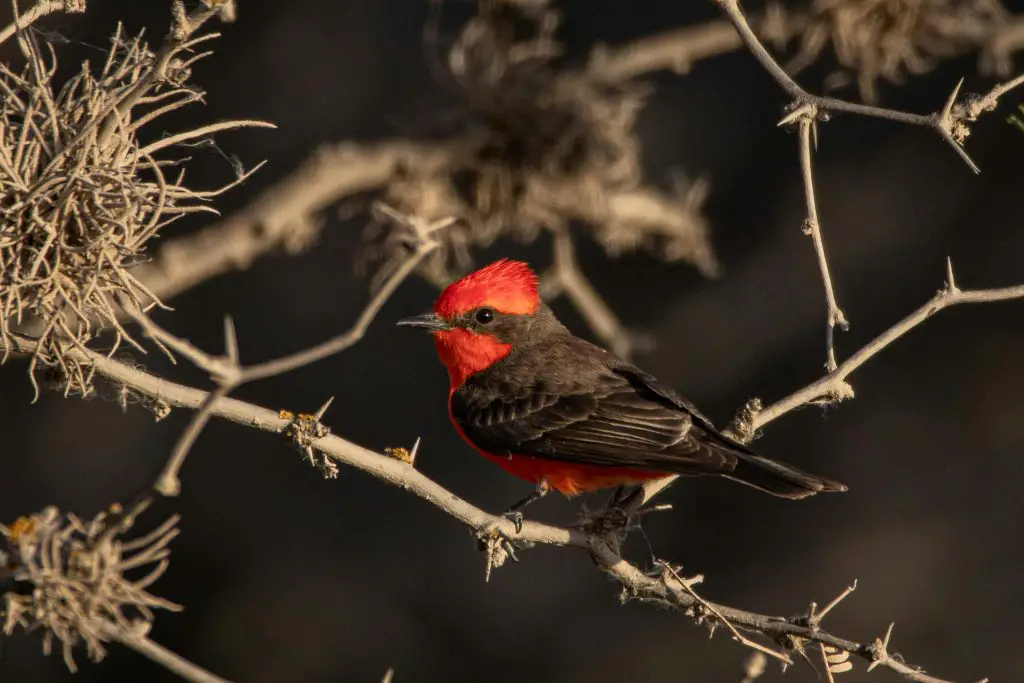
Reproduction, Young, and Molting of Vermilion Flycatcher
The mating behavior of the Vermilion Flycatcher involves an elaborate courtship display by the males, which includes aerial acrobatics and singing to attract females. Males perform intricate dance routines high in the sky, puffing up their chests and engaging in fluttery fights to impress potential mates. This courtship ritual culminates in mating, after which the male may engage with other females while the female lays eggs in various nests.
However, only a small percentage of offspring (approximately 11%) result from this behavior, indicating that it is not prevalent within the total population. Most females construct nests and lay eggs in their chosen nesting sites, typically 2 to 4 eggs per clutch. These eggs are white with dark spots and are incubated for about two weeks before hatching into chicks.
Both parents participate in feeding and caring for the hatchlings, although brood parasitism may result in some young being tended to by other birds. After approximately 15 days, the chicks fledge from the nest and become independent. They reach sexual maturity at around two years of age, completing the life cycle of the Vermilion Flycatcher.
Molting, the process of shedding old feathers and replacing them with new ones, occurs after the migration season, typically from July to September. This process is crucial for maintaining feather quality and flight performance. Molting can last up to 79 days, with feathers being gradually replaced to avoid issues with flight due to underdeveloped feathers.
Population
The Vermilion Flycatcher boasts a substantial population size, estimated to range from 5,000,000 to 50,000,000 individuals. This large population, coupled with their migratory behavior, contributes to their classification as Least Concern in terms of endangered status.
Despite their current stable population trend, the Vermilion Flycatcher faces potential threats to its survival. Urbanization and habitat loss pose significant challenges by reducing suitable nesting and foraging habitats. Additionally, the overuse of pesticides negatively impacts insect populations, diminishing the primary food source for Vermilion Flycatchers. If these threats continue to escalate, they could pose a risk to the species’ long-term viability.
Monitoring and addressing these threats through habitat conservation efforts, sustainable land management practices, and pesticide regulation are essential to ensuring the continued survival and well-being of the Vermilion Flycatcher population. By mitigating these risks, we can help safeguard this charismatic bird species and maintain its status as a Least Concern species.
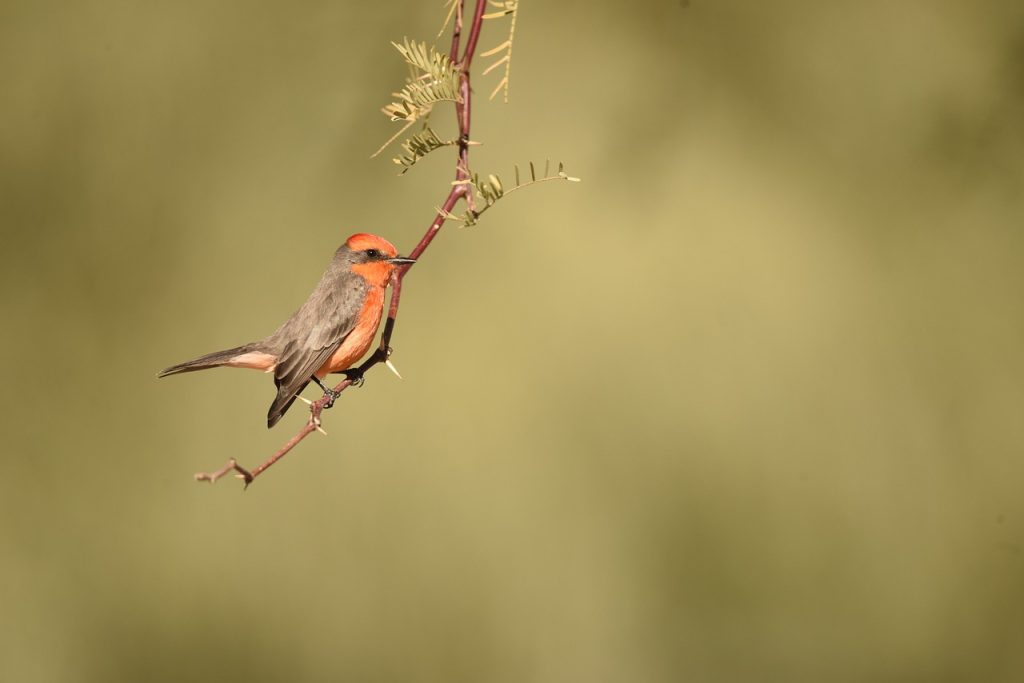
Conclusion
The Vermilion Flycatcher, with its vibrant plumage, melodious songs, and agile flight, captivates both bird enthusiasts and casual observers alike. Despite facing threats such as habitat loss and pesticide use, its adaptable nature and large population size have earned it a status of Least Concern. Through conservation efforts aimed at preserving its natural habitats and mitigating human-induced impacts, we can ensure the continued survival of this charismatic species for generations to come.
